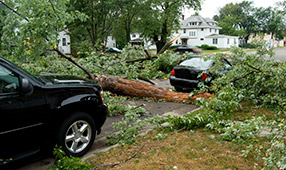Having a new driver in the family can be an exciting yet terrifying time. It means a newfound freedom for your teen, but also lots of worrying about distractions, their inexperience and aggressive drivers they might encounter.
We all want our children to be safe when they take to the roads, and to be prepared for the unexpected. These safety tips can help make sure they’re ready when they get behind the wheel.
1. Driver education is invaluable
A dilemma for many parents is deciding whether to teach their child to drive, or leave it up to an expert. Not all states require driver’s education to get a license. However, most do require some driver experience.
The National Highway Traffic Safety Administration (NHTSA) recommends enrolling new drivers in a driver’s education program to help develop life-long safe driving habits. Each state has a list of approved driver’s education programs, often found on your state’s department of motor vehicles website. A resource for all states can be found at dmv.org/drivers-ed.php.
To ensure young drivers have the training and experience they need, safety groups are pushing for a national, mandatory graduated driver licensing system (GDL), which has been proven to save lives. The three GDL stages are:
- Learner: supervised driving, limit of passengers and preparing for a driving test
- Intermediate: limited unsupervised driving in high-risk situations
- Full Privilege: standard driver’s license
Most GDL programs prohibit cellphone use, restrict nighttime driving and limit the number of passengers allowed.
2. Drive the point home with a safe vehicle
The Insurance Institute for Highway Safety does extensive crash tests on cars and trucks to rate them for safety. Because many parents opt for a used vehicle for new teen drivers, they created a list of those that meet important safety criteria, with prices ranging from $2,000 to nearly $20,000. They found 53 “Best Choices” under $20,000, and 62 “Good Choices” that start at under $10,000.
Some of the “Best Choice” vehicles $20,000 or less include:
- 2007 and newer Volvo S80 – large cars ($4,000)
- 2013 and newer (built after October 2012) Volkswagen Passat – midsized cars ($6,600)
- 2014 and newer (built after October 2013) Mazda CX-5 – small SUVs ($10,700)
- 2005 and newer Volvo XC90 – midsized SUVs ($3,700)
- 2014 and newer Honda Odyssey – minivans ($12,700)
- 2016 and newer Toyota Tacoma Access cab – small pickup ($18,100)
- 2014 and newer Toyota Tundra Double cab – large pickup ($19,000)
These are some of the recommendations for “Good Choices” priced at $10,000 or less:
- 2010-2016 Buick LaCrosse – large cars ($6,200)
- 2009-2014 Volkswagen Jetta sedan and wagon – midsize cars ($3,800)
- 2007-2011 Honda Element – small SUVS ($4,400)
- 2006-2014 Subaru Tribeca/B9 Tribeca – midsize SUVs ($4,100)
- 2012-2017 Chevrolet Traverse – large SUVS ($9,300)
- 2012 Volkswagen Routan – minivans ($6,400)
- 2007-2013 Toyota Tundra double cab – pickups ($8,600)
When shopping for a vehicle for younger drivers, The IIHS and the National Highway Safety Institute recommend:
- Looking for bigger, heavier vehicles that offer more protection (no mini or small cars were on the list)
- Avoiding vehicles with high horsepower
- Considering vehicles with an electronic stability control system to maintain traction and control on curves and slippery roads
3. Create a pre-flight checklist
Before you let your new driver start on the road to independence, check that he or she knows the vehicle and understands safe operating procedures. For example:
- Adjusts the seat and mirrors before leaving the driveway
- Puts on seat belts and ensures all passengers are buckled in
- Uses turn signals
- Looks in all directions before pulling into traffic (even at green lights)
- Accelerates and brakes smoothly
- Follows at a safe distance
- Avoids distractions
To help mitigate confrontations with irate drivers, parents can put a “New Driver” sticker on the car, truck or SUV that the inexperienced driver will be use.
4. Prevent distracted and reckless driving
Distracted and inattentive driving is one of the leading causes of crashes for all drivers, but especially for teens. The crash rate for newly licensed teens was almost double that of teen drivers with a few years of experience, according to the NHTSA.
Here are some strategies to help prevent inattentive driving:
- Parents and teens can pledge to avoid texting or using social media behind the wheel
- Use apps that block incoming calls and texts, and send alerts when the app is turned off
- Teach children to speak out they see a driver who’s distracted
- Promise not to speed, goof off or drive impaired (or get into a car with someone who is upset or impaired)
- Map out routes and create music lists before heading out
Parents aren’t alone in their concern for teen drivers. To reduce the number of crashes involving teen drivers, the nonprofit Impact Teen Drivers (ITD) teams up with educators, law enforcement agencies and health care workers across the U.S. to educate young drivers about the dangers of distracted and careless driving.
Impact Teen Drivers offers classroom curriculum for educators, at impactteendrivers.org. Students can enter the Create Real Impact contest by creating art, videos, essays and music that addresses the danger of inattentive driving.
5. Fully insure your teen drivers
Higher auto insurance rates are a hard reality for parents with a new, young driver. Adding a newly licensed driver to your insurance policy can increase premiums by an average of 80%, or about $700.
Here are some ways to help manage the higher costs of insuring teen drivers:
- Take advantage of “good student” discounts
- Purchase cars that have modern safety features and a good safety rating
- Consider a monitoring system that tracks your young driver’s habits
- Enroll them in a defensive driving course
- Cut driving miles by carpooling and using mass transit
- Find an insurer who treats teens as responsible drivers
You should also review your liability insurance. The increased risk of a serious crash caused by an inexperienced driver means you may need extra coverage to protect your assets. Contact your insurance provider and make sure you have as much liability insurance as you can afford.
Hopefully, your teen driver will gain experience, and you’ll feel more confident each time they get behind the wheel, knowing they are in the safest vehicle, armed with the best advice, and are paying attention to the road and other drivers.












